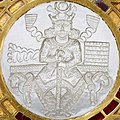Dokhtar-i-Noshirwan
35°45′33″N 67°52′34″E / 35.759179°N 67.876073°E / 35.759179; 67.876073Type Settlement Site notes Excavation dates 1928 Condition Ruined Polities Culture Archaeology Artifacts
Dokhtar-i-Noshirwan, also Nigar, is an archaeological site in the Ḵolm valley in northern Afghanistan.[1][2] It is located 100 kilometers north of Bamiyan and has the largest non-Buddhist mural in Afghanistan.[2]
The mural represent a local ruler, possibly Hephthalite,[3][2] in an attitude similar to that of Khosrau II on one of his silver plates: seated frontally with legs spread out and his hands on a large swords standing between his knees.[2] The crown is formed by the head of a beast, framed by two wings, similar to a design known from the coins of Shahi Tegin.[2]
The artists of Dokhtar i-Noshirwan for may have come from Bamiyan or Kakrak.[3]
-
 Silver plate of Khosrau I (531 to 579 CE).
Silver plate of Khosrau I (531 to 579 CE). -
 Plate depicting the Sasanian king Khosrow I (531 to 579 CE).
Plate depicting the Sasanian king Khosrow I (531 to 579 CE). -
 A coin of Shahi Tegin.
A coin of Shahi Tegin.
References
- ^ "DOḴTAR-E NŌŠERVĀN – Encyclopaedia Iranica". iranicaonline.org.
- ^ a b c d e Rowland, Benjamin (1974). The Art of Central Asia. p. 94. Archived from the original on 2023-01-15. Retrieved 2020-11-19.
- ^ a b Klimburg-Salter, Deborah (1993). "Dokhtar-i-Noshirwan (Nigar) Reconsidered". Muqarnas. 10: 355–368. doi:10.2307/1523200. ISSN 0732-2992.
- v
- t
- e
- Mal'ta–Buret' culture
- Yamnaya culture
- Afanasievo culture
- Sintashta culture
- Vakhsh culture
- Bactria–Margiana Archaeological Complex
- Saka
- Andronovo culture
- Tagar culture
- Uyuk culture
- Pazyryk culture
- Massagetae
- Median Empire
- Achaemenid Empire
- Macedonian Empire
- Seleucid Empire
- Greco-Bactrian Kingdom
- Guiyi Circuit
- Yuezhi
- Xiongnu
- Kushan Empire
- Kushano-Sasanians
- Kidarites
- Alchon Huns
- Hephthalites
- Tocharians
- Ustrushana
- Khuttal
- Farghana
- First Turkic Khaganate
- Western Turks
- Tang dynasty (Anxi Protectorate)
- Ikhshids of Sogdia
- Tokhara Yabghus
- Turk Shahis
- Oghuz Yabgus
- Second Turkic Khaganate
- Uyghur Khaganate
- Abbasid Caliphate
- Tahirid dynasty
- Saffarid dynasty
- Samanids
- Ma'munids
- Farighunids
- Ghaznavids
- Great Seljuq Empire
- Ghurid Empire
- Khwarazmian Empire
- Mongol Empire
- Chagatai Khanate
- Golden Horde
- Ilkhanate
- Sufi dynasty
- Kart dynasty
- Timurid Empire
- Khanate of Bukhara
- Durrani Empire
- Khanate of Khiva
- Chinese Turkestan
- Russian Turkestan
- Soviet Central Asia
- Chinese Central Asia
- Sokh snakes
- Orlat plaques
- Hephthalite silver bowl
- Chilek silver bowl
- Gardez Ganesha
- Mogao Christian painting
- Murals from the Christian temple at Qocho
- Penjikent murals
- Sampul tapestry
- Sogdian Daēnās
- Oxus Treasure
- Bimaran Casket
- Buddhas of Bamiyan
- Kabul hoard
- Aramaic Inscription of Laghman
- Kandahar Aramaic inscription
- Pul-i-Darunteh Aramaic inscription
- Kandahar Bilingual Rock Inscription
- Kandahar Greek Edicts of Ashoka
- Afrasiab murals
- Stamp seal (BM 119999)
- Seal of Khingila
- Siberian Ice Maiden
- Ai-Khanoum plaque
- Saksanokhur gold buckle
- Boar hunter (Hermitage Museum)
- Siberian Collection of Peter the Great













